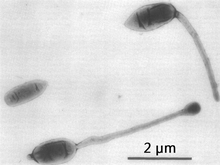ヒフォミクロビウム科
出典: フリー百科事典『ウィキペディア(Wikipedia)』 (2023/03/11 02:36 UTC 版)
| ヒフォミクロビウム科 | |||||||||||||||
|---|---|---|---|---|---|---|---|---|---|---|---|---|---|---|---|
 3個のHyphomicrobium sp.の細胞。2個は、母菌糸の残骸であろう突起を持つ。 | |||||||||||||||
| 分類 | |||||||||||||||
| |||||||||||||||
| 学名 | |||||||||||||||
| Hyphomicrobiaceae Babudieri 1950[1] (IJSEMリストに記載 1980[2]) | |||||||||||||||
| タイプ属 | |||||||||||||||
| ヒフォミクロビウム属 Hyphomicrobium Stutzer and Hartleb 1899[3] (IJSEMリストに記載 1980[2]) | |||||||||||||||
| 属[20] | |||||||||||||||
|
ヒフォミクロビウム科(Hyphomicrobiaceae)はプロテオバクテリア門アルファプロテオバクテリア綱ヒフォミクロビウム目の科の一つである。
概要
この科の細菌は形態学的に非常に多彩であり、生息地も土壌、淡水、地下水、湿地、植物の根圏、硝化菌液、ニワトリ、下水など多様である[21]。極わずかな菌種(例:Dichotomicrobium thermohalophilum、Filomicrobium fusiforme、Hyphomicrobium aestuarii)に限られるが、海洋環境からも分離されている。
系統図
現在の分類体系はList of Prokaryotic names with Standing in Nomenclature (LPSN)の決定に従う。下記の系統発生図は全ゲノム解析の結果に基づく。
| |||||||||||||||||||||||||||||||||||||
脚注
- ^ Babudieri B (1950). “Natura delle cosidette "S-formen" delle leptospire. Loro identificazione con Hyphomicrobium vulgare Stutzer e Hartleb. Studio di quest. Ultimo germe.”. R.C. 1st Supplement. 13. Sanita(Roma). pp. 580-591
- ^ a b c d e f g V. B. D. Skerman, Vicki. McGOWAN, P. H. A. Sneath (01 January 1980). “Approved Lists of Bacterial Names”. International Journal of Systematic and Evolutiona 30 (1): 225-420. doi:10.1099/00207713-30-1-225.
- ^ a b Stutzer A, Hartleb R (1899). “Untersuchungen über die bei der Bildung von Salpeter beobachteten Mikroorganismen”. Mitteilungen des Landwirtschaftlichen Institutes der Kaiserlichen Universitat Breslau 1: 75-100.
- ^ Anton Hördt, Marina García López, Jan P Meier-Kolthoff, Marcel Schleuning, Lisa-Maria Weinhold, Brian J Tindall, Sabine Gronow, Nikos C Kyrpides, Tanja Woyke, Markus Göker (07 April 2020). “Analysis of 1,000+ Type-Strain Genomes Substantially Improves Taxonomic Classification of Alphaproteobacteria”. Frontiers in Microbiology 11: 468. doi:10.3389/fmicb.2020.00468. PMC 7179689. PMID 32373076.
- ^ Aharon Oren, George Garrity (30 July 2020). “List of new names and new combinations previously effectively, but not validly, published”. International Journal of Systematic and Evolutiona 70 (7): 4043-4049. doi:10.1099/ijsem.0.004244.
- ^ P. Hirsch, B. Hoffmann (May 1989). “Dichotomicrobium thermohalophilum, gen. nov., spec, nov., Budding Prosthecate Bacteria from the Solar Lake (Sinai) and Some Related Strains”. Systematic and Applied Microbiology 11 (3): 291-301. doi:10.1016/S0723-2020(89)80027-X.
- ^ “Validation of the Publication of New Names and New Combinations Previously Effectively Published Outside the IJSB Free List No. 311”. International Journal of Systematic and Evolutiona 39 (4): 495-497. (01 October 1989). doi:10.1099/00207713-39-4-495.
- ^ Heinz Schlesner (November 1987). “Filomicrobium fusiforme gen. nov., sp. nov., a Slender Budding, Hyphal Bacterium from Brackish Water”. Systematic and Applied Microbiology 10 (1): 63-67. doi:10.1016/S0723-2020(87)80012-7.
- ^ “Validation of the Publication of New Names and New Combinations Previously Effectively Published Outside the IJSB”. International Journal of Systematic and Evolutiona 38 (2): 220-222. (01 April 1988). doi:10.1099/00207713-38-2-220.
- ^ Li Li, Ghenijan Osman, Nimaichand Salam, Osama Abdalla Mohamed, Jianyu Jiao, Jinbiao Ma, Mipeshwaree Devi Asem, Min Xiao & Wen-Jun Li (22 January 2018). “Limoniibacter endophyticus gen. nov., sp. nov., an alphaproteobacterium isolated from the roots of Limonium otolepis”. Archives of Microbiology 200 (4): 663–670. doi:10.1007/s00203-017-1472-0. PMID 29356837.
- ^ Aharon Oren, George M. Garrity (04 January 2019). “List of new names and new combinations previously effectively, but not validly, published”. International Journal of Systematic and Evolutiona 69 (1): 5-9. doi:10.1099/ijsem.0.003174.
- ^ Mio Takeuchi, Taiki Katayama, Takao Yamagishi, Satoshi Hanada, Hideyuki Tamaki, Yoichi Kamagata, Kenshiro Oshima, Masahira Hattori, Katsumi Marumo, Munetomo Nedachi, Hiroto Maeda, Yuichi Suwa, Susumu Sakata (01 February 2014). “Methyloceanibacter caenitepidi gen. nov., sp. nov., a facultatively methylotrophic bacterium isolated from marine sediments near a hydrothermal vent”. International Journal of Systematic and Evolutiona 64 (Pt_2): 462-468. doi:10.1099/ijs.0.053397-0. PMID 24096357.
- ^ Aharon Oren, George M. Garrity (01 May 2014). “Notification that new names of prokaryotes, new combinations, and new taxonomic opinions have appeared in volume 64, part 2, of the IJSEM”. International Journal of Systematic and Evolutiona 64 (Pt_5): 1459-1460. doi:10.1099/ijs.0.063446-0.
- ^ Nina V Doronina, Maria N Poroshina, Elena N Kaparullina, Vladimir A Ezhov, Yuri A Trotsenko. “Methyloligella halotolerans gen. nov., sp. nov. and Methyloligella solikamskensis sp. nov., two non-pigmented halotolerant obligately methylotrophic bacteria isolated from the Ural saline environments”. Systematic and Applied Microbiology 36 (3): 148-154. doi:10.1016/j.syapm.2012.12.001. PMID 23351489.
- ^ Aharon Oren, George M. Garrity (01 March 2014). “List of new names and new combinations previously effectively, but not validly, published”. International Journal of Systematic and Evolutiona 64 (Pt_3): 693-696. doi:10.1099/ijs.0.062521-0.
- ^ Aristovskaya TV. (1961). “Accumulation of iron by decomposing organo-mineral complexes of humid matter by microorganisms”. Doklady Akademii Nauk SSSR 136: 954-957.
- ^ James T. Staley. “Prosthecomicrobium and Ancalomicrobium: New Prosthecate Freshwater Bacteria”. Journal of Bacteriology 95 (No. 5): 1921-42. doi:10.1128/jb.95.5.1921-1942.1968. PMC 252228. PMID 4870285.
- ^ Esther Duchow, H. C. Douglas. “RHODOMICROBIUM VANNIELII, A NEW PHOTOHETEROTROPHIC BACTERIUM”. Journal of Bacteriology 58 (No. 4): 409-16. doi:10.1128/jb.58.4.409-416.1949. PMC 385647. PMID 16561801.
- ^ Aristovskaya TV, Parinkina OM (1963). “A new soil microorganism Seliberia stellata n. gen. n. sp. (in Russian)”. Bulletin of the Academy of Sciences USSR (Series Biology) 218: 49-56.
- ^ J. P. Euzéby. “Family Hyphomicrobiaceae”. List of Prokaryotic Names with Standing in Nomenclature. 2023年3月6日閲覧。
- ^ Garrity, G. M., Bell, J. A. & Lilburn, T. (2005). “Family VIII. Hyphomicrobiaceae Babudieri 1950, 589”. In D. J. Brenner, N. R. Krieg, J. T. Staley & G. M. Garrity. Bergey's Manual of Systematic Bacteriology, 2nd edn, vol. 2, The Proteobacteria, part C, The Alpha-, Beta-, Delta-, and Epsilonproteobacteria. Springer (New York). p. 476
- ヒフォミクロビウム科のページへのリンク